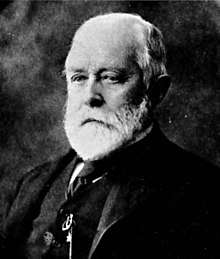Robert Bruce Foote
| Robert Bruce Foote | |
|---|---|
 | |
| Born | 22 September 1834 |
| Died |
29 December 1912 (aged 78) Calcutta |
| Resting place | Holy Trinity Church, Yercaud, Tamil Nadu, India |
| Known for | Geology and archaeology of India |
Robert Bruce Foote (22 September 1834 – 29 December 1912) was a British geologist and archaeologist who conducted geological surveys of prehistoric locations in India for the Geological Survey of India.
Foote joined the Geological Survey of India (GSI) on 29 December 1858 was posted in the Madras Presidency, Hyderabad region and Bombay. In 1887 he became a director of the GSI and on retiring in 1891, he joined the state of Baroda. In later life, he settled in Yercaud where his father in law Reverend Peter Percival had worked and lived.[1]
An interest in paleolithic life was inspired by the work of Joseph Prestwich in 1859. In 1863, the year after his archaeological survey began, he discovered the first conclusive Paleolithic stone tool (a hand axe) in India. He found the tool in southern India (Pallavaram, near Madras). After the discovery he, along with William King, went on to discover more such tools and settlements in Southern and Western India. In 1884 he discovered the 3.5 kilometres (2.2 mi) long Belum Caves, the second largest cave in the Indian subcontinent.[2] Foote spent 33 years (starting at age 24) working for the geological survey. He is often considered the "Father of Indian Prehistory".[3]
As a geologist, one of his significant contribution to Indian Geology is his memoir (Vol. XII) published by Geological Survey of India in 1876, titled "Geological Features of the South Mahratta Country and Adjacent Districts" (i.e. Border districts of Maharashtra, Karnataka and Andhra Pradesh States, India). Even today, his memoir with its graphical language is a treat to 'read and follow' for the amateur geologists who want to study the rock successions of the northern Dharwar craton of South India.
He died on 29 December 1912 and was cremated at Calcutta, his ashes were deposited at Holy Trinity Church, Yercaud, Tamil Nadu, India. There is a memorial to him there.[4] Foote was a Fellow of the Geological Society, London from 1867 and a Fellow of the Royal Anthropological Institute.
Foote built a valuable collection as a result of 40 years of geological and pre-historic expeditions in various parts of western and southern India. Foote's collection of antiquities were all sold to the Madras Government Museum in 1906, where is considered a valuable treasure.[5]
His grandson was Major General Henry Bowreman Foote, who won the Victoria Cross during World War 2.
See also
References
- ↑ Chakrabarti, Dilip K. (1979). "Robert Bruce Foote and Indian Prehistory". East and West. 29: 11–26. JSTOR 29756503.
- ↑ "Underground adventure in Belum caves". Deccan Herald. 27 January 2008. Archived from the original on 2 June 2008.
- ↑ Prehistoric Antiquities and Personal Lives: The Untold Story of Robert Bruce Foote, Shanti Pappu, Man and Environment, XXXIII(1): 30-50 (2008)
- ↑ Subramanian, T (8 July 2009). "The trail of two British innovators in India". The Hindu. Retrieved 2 January 2013.
- ↑ Rao, Satyanarayana (4 June 2013). "Tracing Foote's steps in Bellary" (Bangalore). Deccan Herald. Retrieved 2 February 2015.